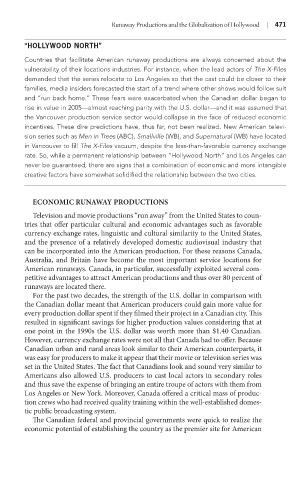Page 492 - Battleground The Media Volume 1 and 2
P. 492
Runaway Product ons and the Global zat on of Hollywood | 1
“hollywood north”
Countries that facilitate American runaway productions are always concerned about the
vulnerability of their locations industries. For instance, when the lead actors of The X-Files
demanded that the series relocate to Los Angeles so that the cast could be closer to their
families, media insiders forecasted the start of a trend where other shows would follow suit
and “run back home.” These fears were exacerbated when the Canadian dollar began to
rise in value in 2005—almost reaching parity with the U.S. dollar—and it was assumed that
the Vancouver production service sector would collapse in the face of reduced economic
incentives. These dire predictions have, thus far, not been realized. New American televi-
sion series such as Men in Trees (ABC), Smallville ( WB), and Supernatural ( WB) have located
in Vancouver to fill The X-Files vacuum, despite the less-than-favorable currency exchange
rate. So, while a permanent relationship between “Hollywood North” and Los Angeles can
never be guaranteed, there are signs that a combination of economic and more intangible
creative factors have somewhat solidified the relationship between the two cities.
EConomiC runaway ProDuCTions
Television and movie productions “run away” from the United States to coun-
tries that offer particular cultural and economic advantages such as favorable
currency exchange rates, linguistic and cultural similarity to the United States,
and the presence of a relatively developed domestic audiovisual industry that
can be incorporated into the American production. For these reasons Canada,
Australia, and Britain have become the most important service locations for
American runaways. Canada, in particular, successfully exploited several com-
petitive advantages to attract American productions and thus over 80 percent of
runaways are located there.
For the past two decades, the strength of the U.S. dollar in comparison with
the Canadian dollar meant that American producers could gain more value for
every production dollar spent if they filmed their project in a Canadian city. This
resulted in significant savings for higher production values considering that at
one point in the 1990s the U.S. dollar was worth more than $1.40 Canadian.
However, currency exchange rates were not all that Canada had to offer. Because
Canadian urban and rural areas look similar to their American counterparts, it
was easy for producers to make it appear that their movie or television series was
set in the United States. The fact that Canadians look and sound very similar to
Americans also allowed U.S. producers to cast local actors in secondary roles
and thus save the expense of bringing an entire troupe of actors with them from
Los Angeles or New York. Moreover, Canada offered a critical mass of produc-
tion crews who had received quality training within the well-established domes-
tic public broadcasting system.
The Canadian federal and provincial governments were quick to realize the
economic potential of establishing the country as the premier site for American

